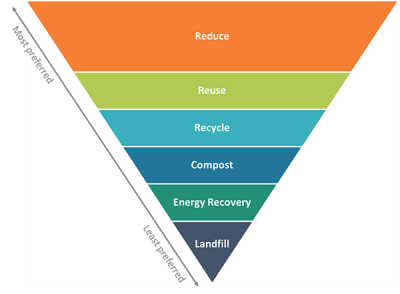Waste Prevention
Waste prevention is very different from recycling. Recycling redirects discarded material from the landfill, and prevents materials from entering the waste stream. Waste prevention is about changing habits in regards to what and how we use resources. It is the best practice to reduce waste, affecting both the upstream and downstream effects on our environment, by reducing resource extraction, manufacturing, transportation and end-of-life management.
 Buying habits
Buying habits
Are you a waste-aware shopper? Choose quality materials for longer use and reuse. Look for minimal, reusable or recyclable materials and packaging.
Consider what waste can be avoided completely. What items do you use that will go to the landfill? Can you reduce your use or do without them?
Avoid single-use plastics, such as plastic bags, soda and water bottles and food packaging. Reducing or eliminating the purchase of these products will reduce the amount of waste.
- Use a reusable stainless steel or glass water bottle.It’s less expensive and better for the environment.
- Avoid disposable table settings and “to go” packaging. Cook your meals at home more often.
- To reduce packaging, buy in bulk. Bring your own reusable bags when shopping for bulk or produce items.
Purchase second-hand and products made from recycled materials.
When purchasing clothing, Make Every Thread Count. Look for well-made clothing that will last. Care for your clothes by cleaning correctly and repairing. When it is no longer needed, donate or resell it.
Swap, share or repair. Learn repair skills and prolong the life of the things you buy. If there is something that you use infrequently, consider sharing or trading it with a neighbor or friend.
 Food Waste
Food Waste
It is estimated that between 25 and 40 percent of all food in the United States is never eaten. The resources that it takes to grow, produce, distribute, refrigerate, prepare and dispose of these foods is wasted. Some simple strategies can help reduce this wasted resource and save money. By establishing a strategy for shopping, food storage and preparation, preventing food waste is easy. No Food Left Behind provides some helpful tools. Finally, supporting locally produced food reduces the environmental impacts of transportation and helps keep money local.